I’M NO MICHELANGELO, BUT . . .
Lawn Nouveau
I’m taking up sculpture. Not in bronze, Carrara marble, or granite, but with plants.
My easiest sculpture is one I’ve been doing for years. I can’t really say “working on for years” because every year it vanishes, to be started anew each spring. It’s “lawn nouveau,” as I call it in my book, The Pruning Book, and then go on to describe the technique as “two tiers of grassy growth . . . the low grass is just like any other lawn, and kept that way with a lawnmower. The taller portions are mowed infrequently – one to three times a year, depending on the desired look (and my need for hay) — with a scythe or tractor.” The sharp, defining line between the high grass and the low grass is integral to the design.

I’m lucky to have a meadow bathed in sunlight bordering the south side of my property. But even a small yard might be able to accommodate lawn nouveau. My three-quarter of an acre yard did before the meadow shifted to my care. (Previous owners had maintained it as very large lawn with weekly or biweekly mowing.)
This sculpture has many pieces to it.
One is how I manage it with mowing the whole meadow either at the end or the beginning of the growing season, a necessary task or the meadow will naturally revert over time to forest. Even a once a year mowing might be insufficient, as I realized a couple of years ago with the increasing encroachment of woody shrubs and vines such as poison ivy, grape, and multiflora rose.
Repeated mowing during one season brought the meadow back in order, mostly with grasses. Over time I expect and hope for a resurgence also of more goldenrods, bee balms, and other herbaceous, flowering plants.

The look of the meadow is also influenced by a season’s weather. And by the progress of the season, the meadow’s appearance being very different as grasses morph from succulent green leaves in spring to late summer’s tawny shoots and seed heads. Late summer also brings on showy flowers.
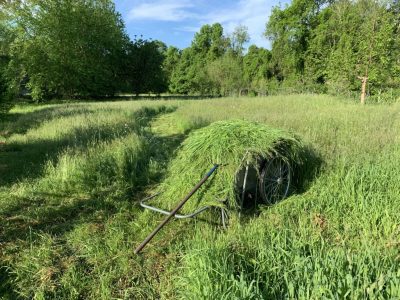
Even the time of day; it’s early morning appearance is quite different than its appearance at various times throughout the day, all dependent also, of course, on what’s happening up in the sky. All this making for a very interesting sight of varying beauty.
A lot of this is either beyond my control or very unpredictable. What is neither is my mowing during the growing season. Each spring I lay out a path, maintained by mowing with my tractor, that wends its way through the meadow.

The goal is to make it inviting and practical. Practical because it carries you to the end of the meadow into a bosk of maples, river birches, and one large buartnut tree, and then on to a studio building.

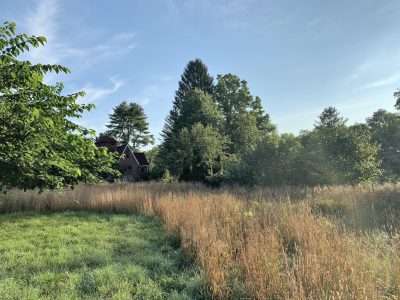
This year I decided to also sculpt more edges of the meadow, cutting the high grass with a scythe to a pattern that matches the flow of the path within. One of my favorite views of the meadow is from an upstairs window, its height allowing me to visually swallow the whole view.
A Head for Yew
Another plant sculpture here is a large yew that I’m carving to become a fifteen foot high head. This one is easy enough because I’m merely copying one of a series of such heads living in a public garden in Britain.
The bush is old, 40 years at least, and has always been pruned to a cone shape with slightly rounded rather than straight sides.
Creating the facial features has involved some deep pruning down into the center of the bush. Yew is a forgiving plant, readily resprouting from even old wood. Problem is that some of those interior stems are old and dead.
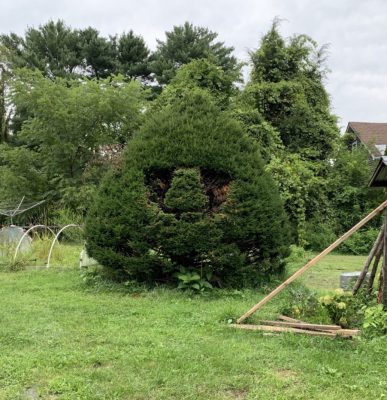
The challenge, then, is time, to be patient for sprouts to grow where light now is penetrating. And then to trim those sprouts so that all levels of the sculpture present green surfaces.
Cloudy Aspirations
And finally, my most difficult sculpture, one for which I each year claim improvement, but not success. The plants: yews again. In this case, there are four of them, all maintained four to five feet high so as not to block the windows of the wall they front.
Originally, they were pruned as a standard yew-along-house-foundation hedge. A few years ago, I morphed them into something more interesting and humorous, a giant caterpillar, with some success. (My inspiration here was the work of Keith Buesing, topiarist extraordinaire of Gardiner, New York.)
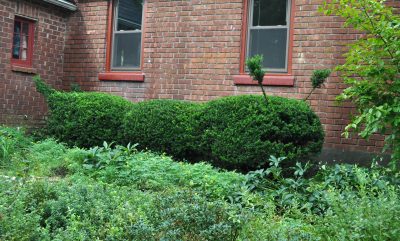
More recently for these plants, I decided to try a method of pruning known as okarikomi, a technique that originated in Japan. In this case, a group of shrubs, rather than maintaining their individual identity, are pruned to flow together to create a scene reminiscent of billowing clouds or a distant, rolling landscape.
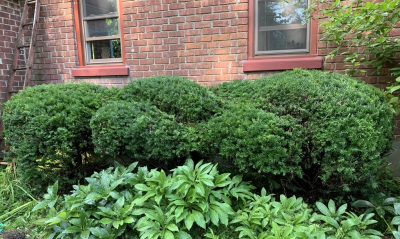
Thus far, I’m not pleased with my pruning. But every year I make some changes and it looks better than it did the previous year.
Plants are very forgiving. Every year, even during each growing season, I have opportunity to change my sculptures according to my whims or what looks nicer to me. What will the meadow, the yew head, and the okarikomi yews look like next year?
And Composting
In case you didn’t notice my previous post, I will be holding a composting workshop/webinar Wednesday, September 23, 2020 at 7 PM. For more information, go to www.leereich.com/workshops.



Liked the recommendations regarding “sculpting” meadows!
Gee, I wonder which one of the sculptures is a self-portrait..?
Beautiful teaching on nature and its effect on us and vice versa. A couple of summers ago I cancelled our lawn service and got a battery-powered lawnmower. I love the freedom it gives me to respond to the season and the need – mowing the lawn short near the house to discourage ticks, and letting it grow longer at the bottom of the yard where the wild oregano flowers.
It would be cool if we could see an aerial view of your sculpted meadow?
Does anybody want to buy me a drone? 🙂
Very cool, Lee! You have endless energy, both creative and work horse type. I love the VARIETY!